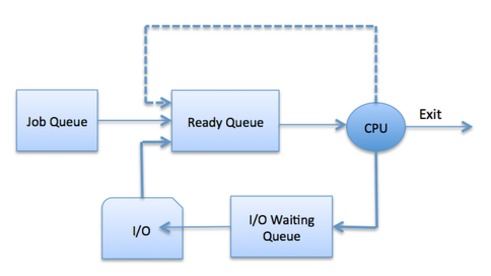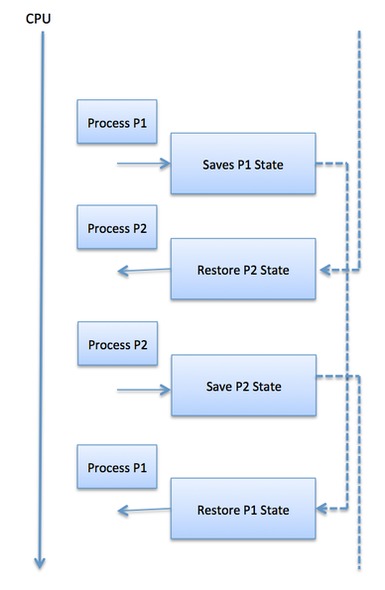Scheduling Queues


Short Term Scheduler :-
The short-term scheduler (also known as the CPU scheduler) decides which of the ready, in-memory processes is to be executed (allocated a CPU) after a clock interrupt, an I/O interrupt, an operating system call or another form of signal.
Note: Short term scheduler only selects the process to schedule it doesn’t load the process on running.
Dispatcher is responsible for loading the selected process by Short Term scheduler on the CPU (Ready to Running State) Context switching is done by dispatcher only. A dispatcher does following:
1) Switching context.
2) Switching to user mode.
3) Jumping to the proper location in the newly loaded program.
Medium Term Scheduler :-
The medium-term scheduler temporarily removes processes from main memory and places them in secondary memory (such as a hard disk drive) or vice versa,which is commonly referred to as "swapping out" or "swapping in" (also incorrectly as "paging out" or "paging in"). The medium-term scheduler may decide to swap out a process which has not been active for some time, or a process which has a low priority, or a process which is page faulting frequently, or a process which is taking up a large amount of memory in order to free up main memory for other processes, swapping the process back in later when more memory is available.

- Job queue − This queue keeps all the processes in the system(
- Ready queue − This queue keeps a set of all processes residing in main memory, ready and waiting to execute. A new process is always put in this queue.
- Device queues − The processes which are blocked due to unavailability of an I/O device constitute this queue.(

A new process is initially put in the ready queue. It waits in the ready queue until it is selected for execution(or dispatched). Once the process is assigned to the CPU and is executing, once of several events could occur.
- The process could issue an I/O request, and then be placed in an I/O queue.
- The process could create a new subprocess and wait for its termination.
- The process could be removed forcibly from the CPU, as a result of an interrupt, and be put back in the ready queue.
Types of Schedulers
There are three types of schedulers available :
Long Term Scheduler :-
The long-term scheduler, or admission scheduler, decides which jobs or processes are to be admitted to the ready queue (in main memory).
The long-term scheduler is responsible for controlling the degree of multiprogramming.
In general, most processes can be described as either I/O-bound or CPU-bound. An I/O-bound process is one that spends more of its time doing I/O than it spends doing computations. A CPU-bound process, in contrast, generates I/O requests infrequently, using more of its time doing computations. It is important that a long-term scheduler selects a good process mix of I/O-bound and CPU-bound processes. If all processes are I/O-bound, the ready queue will almost always be empty, and the short-term scheduler will have little to do. On the other hand, if all processes are CPU-bound, the I/O waiting queue will almost always be empty, devices will go unused, and again the system will be unbalanced. The system with the best performance will thus have a combination of CPU-bound and I/O-bound processes. In modern operating systems, this is used to make sure that real-time processes get enough CPU time to finish their tasks.
The short-term scheduler (also known as the CPU scheduler) decides which of the ready, in-memory processes is to be executed (allocated a CPU) after a clock interrupt, an I/O interrupt, an operating system call or another form of signal.
Note: Short term scheduler only selects the process to schedule it doesn’t load the process on running.
Dispatcher is responsible for loading the selected process by Short Term scheduler on the CPU (Ready to Running State) Context switching is done by dispatcher only. A dispatcher does following:
1) Switching context.
2) Switching to user mode.
3) Jumping to the proper location in the newly loaded program.
Medium Term Scheduler :-
The medium-term scheduler temporarily removes processes from main memory and places them in secondary memory (such as a hard disk drive) or vice versa,which is commonly referred to as "swapping out" or "swapping in" (also incorrectly as "paging out" or "paging in"). The medium-term scheduler may decide to swap out a process which has not been active for some time, or a process which has a low priority, or a process which is page faulting frequently, or a process which is taking up a large amount of memory in order to free up main memory for other processes, swapping the process back in later when more memory is available.
Comparison among Scheduler
| S.N. | Long-Term Scheduler | Short-Term Scheduler | Medium-Term Scheduler |
|---|---|---|---|
| 1 | It is a job scheduler | It is a CPU scheduler | It is a process swapping scheduler. |
| 2 | Speed is lesser than short term scheduler | Speed is fastest among other two | Speed is in between both short and long term scheduler. |
| 3 | It controls the degree of multiprogramming | It provides lesser control over degree of multiprogramming | It reduces the degree of multiprogramming. |
| 4 | It is almost absent or minimal in time sharing system | It is also minimal in time sharing system | It is a part of Time sharing systems. |
| 5 | It selects processes from pool and loads them into memory for execution | It selects those processes which are ready to execute | It can re-introduce the process into memory and execution can be continued. |



No comments:
Post a Comment